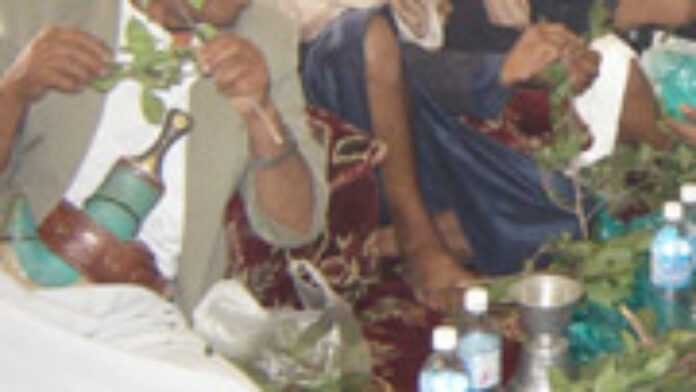
For Ahmed Rajeh, a 54-year-old farmer from Sanaa Governorate, qat is as important as water. “Qat is the [life blood] of our economy,” Rajeh says, adding that he owns more than 500 qat trees and irrigates them with water from a communal cistern.
“We inherited qat cultivation from our forefathers. And it will be the future business for my children as well,” he said, adding that water scarcity in his country does not worry him. “Let us irrigate our crops, and God shall enrich our ground and renew our wells if they dry up,” he said.
However, specialists and officials warn that qat cultivation poses a real threat to the country’s water resources. The National Water Resources Authority (NWRA) estimates Yemen’s total renewable freshwater resources at 2,500 million cubic metres (mcm) a year, of which 1,500mcm is surface water and 1,000mcm groundwater.
Ismael Muharram, head of the Agricultural Research Authority (ARA) in the Ministry of Agriculture, told IRIN that 900mcm ground water is used annually for qat irrigation. “Qat depletes ground water. Its cultivation, which requires water, is increasing because people demand it,” he said.
”Let us irrigate our crops, and God shall enrich our ground and renew our wells if they dry up.”
Seven million chewers
The Combating Qat Damage Association (CQDA), an NGO, estimates there are around seven million chewers of the mild narcotic nationwide, mostly men. Adel al-Shujaa, acting head of the association, told IRIN it had conducted a preliminary survey in 2006 and found 40 million qat trees in the country. “But the actual number could be more,” he said.
On average, farmers harvest qat three to four times a year. According to Muharram, qat trees do not need much water compared with other crops, but farmers give qat more water than it needs.
The cultivation of qat increases by 12 percent a year, according to Abdul-Karim al-Sabri, director of water monitoring and irrigation at the Ministry of Agriculture. “In 1997, some 80,000 hectares were devoted to qat trees; in 2000 the number reached 103,000 hectares; and in 2005 it stood at 123, 933 hectares,” he told IRIN.
Of this area, 81 percent is irrigated by 733mcm of ground water. “If modern irrigation techniques are used in watering qat fields, then between 20 and 30 percent of water can be saved each year. This is equivalent to 183mcm,” al-Sabri said.
According to al-Sabri, in the governorate of Sanaa, qat cultivation covers up to 22,000 hectares, using up to 160mcm annually. “If the new irrigation techniques are used here, then 40 percent of water can be saved. That saved water is equivalent to the quantity used annually by the residents of Sanaa city,” he added.
However, qat trees are irrigated in the traditional manner, whereby the qat fields are flooded, according to al-Sabri. “By this method, a large quantity of water is lost. This is because farmers have to bring water from wells through watercourses until water reaches the farm but the quantity of water taken from the well does not fully reach the fields. Also, when a watercourse is stony, a large quantity of water is wasted before reaching the qat trees. Modern irrigation techniques are rarely used by farmers,” he said.
Al-Sabri added that the ministry of agriculture is supporting farmers by building dams and water divisions for their crops of fruit, vegetables and grains. “But they [farmers] make use of these for qat cultivation,” he said.

